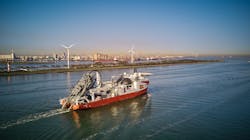Offshore staff
LUXEMBOURG – Subsea 7 has taken delivery of the newbuild reel-lay vessel Seven Vega.
According to Phil Simons, executive vice president Projects & Operations, the new vessel has been designed to install economic flowline technologies that address the growing trend toward longer subsea tiebacks.
These include complex pipe-in-pipe, piggyback and electrically heat-traced flowline systems, risers, umbilicals and structures in water depths up to 3,000 m (9,842 ft).
The Seven Vega, which is now loading pipe, will work on BP’s Manuel project in the US Gulf of Mexico, a two-well subsea tieback to the Na Kika platform, in water depths of up to 1,900 m (6,233 ft).
In September, Subsea 7 also committed to spend $25 million on converting the Seven Phoenix for offshore wind cable-lay work, as its existing cable-lay vessel Seaway Aimery will likely be fully booked through 2022.
Conversion has started and the vessel should re-join the fleet in 2Q 2021.
In addition, the company has issued an update on various ongoing projects in its 3Q results statement.
In Norway, the Seven Arctic completed the last offshore phase of the Snorre Expansion project for Equinor, while the Seven Oceans installed an electrically heat-traced flowline at Ærfugl for Aker BP.
Front-end engineering continued for the next phase of Shell’s Ormen Lange project in the Norwegian Sea.
The Seven Borealis completed installation activities for Shell’s Arran project in the UK central North Sea before heading south to West Africa to work on the Jubilee Turret Remediation and Zinia projects offshore Ghana and Angola, respectively.
In Brazil, the company’s four pipelay support vessels have all been busy, while the Seven Seas continued offshore activities on the Lapa NE project.
Engineering is progressing on the Anchor, King’s Quay, and Jack St Malo projects in the US Gulf of Mexico. Offshore activity also continues on BP’s Mad Dog 2 project.
Subsea 7’s Renewables business unit completed work on Triton Knoll in the North Sea, using the Seaway Strashnov, but progress on the Yunlin project off Taiwan was delayed due to restricted access. The Seaway Yudin was re-deployed to the Formosa 2 project.
As for market prospects, the company sees activity levels rising in the Gulf of Mexico, with a backlog of projects involving low-cost tiebacks to existing infrastructure.
In Brazil, tendering is strong for presalt work, which benefits from favorable oil price breakevens, is robust, and Norway also offers opportunities following the introduction of fiscal incentives.
Elsewhere, notably in the UK, Africa and Asia, prospects are less certain, with timing of certain projects in Saudi Arabia, including Marjan 2, under review by the client.
11/12/2020



